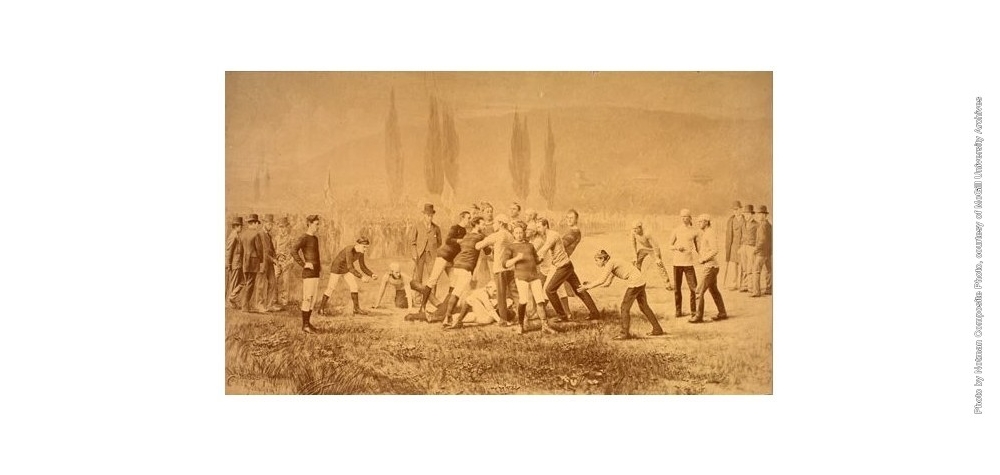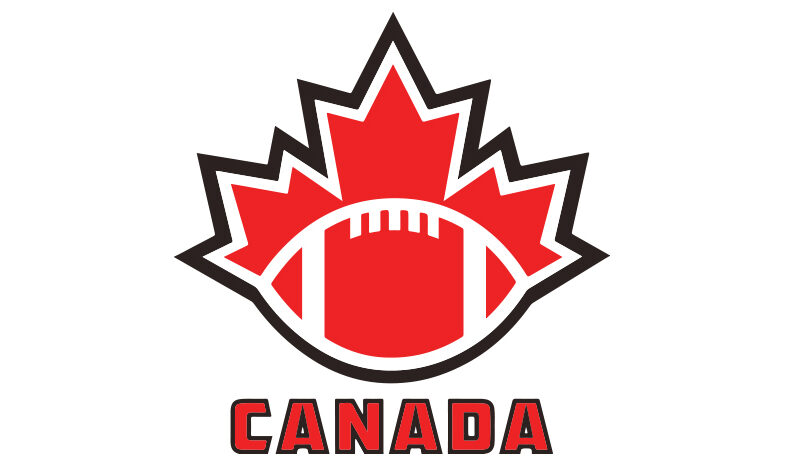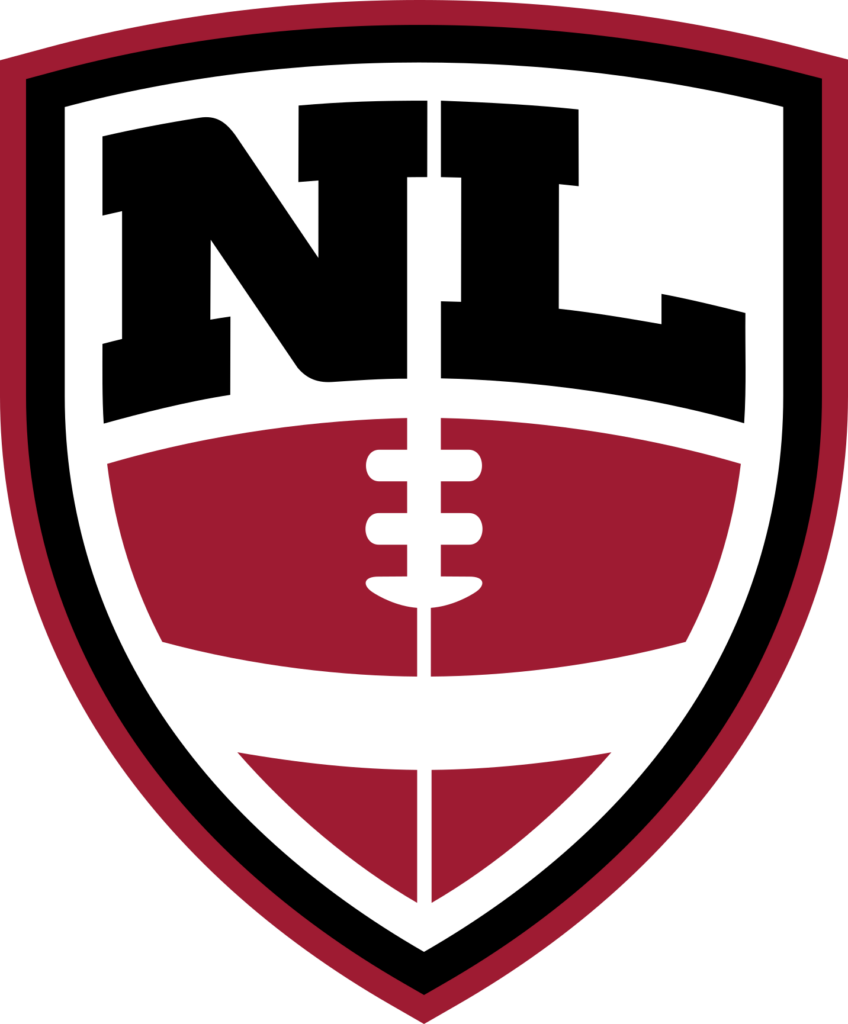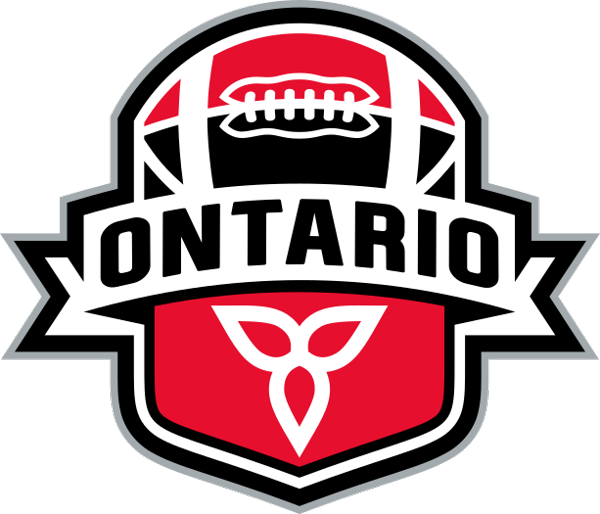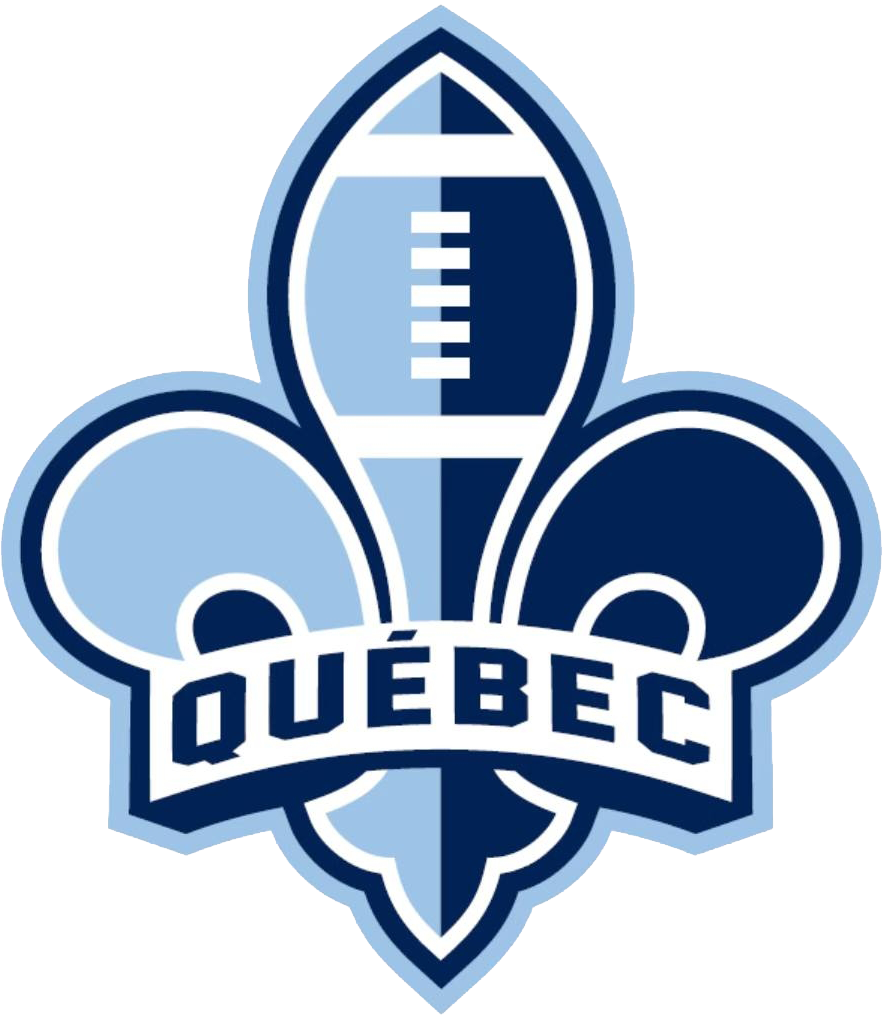First intercollegiate football game was played on May 14, 1874
[su_box title=”Notman Composite Photo”]This famous Notman compostite depicts the third game of the historic McGill-Harvard series of football in 1874, a game played on Oct. 23 at the Montreal Cricket Grounds. The McGill club consisted of the following members: D. Rodgers, captain; O’Hara Baynes, G.E. Jenkins, J.S. Hall, J.B. Abbott, R.W. Huntinden, H. Gilbert, D.E. Bowie, H. Joseph, H.W. Thomas, C. Thomas and P.J. Goodhue. The Harvard club was as follows: H.R. Grant, captain; W.R. Tyler, H. Lombard, A.L. Goodrich, A. Cabot, M. Whitney, W.C. Sanger, F.E. Randall, H.C. Leeds, H.L. Morse and J. Lyman. The game officials, dressed in three-piece suits with top hats, were: R.L. McDonnell, A.F. Ritchie, J.S. McLennan, Walter Hartwell, F.S. Watson, G.E. Jenkins, J.R. Abbott.[/su_box]
(Photo Credit: Notman Composite Photo, courtesy of McGill University Archives)
Source: Earl Zukerman, McGill Athletics
MONTREAL — This week marks the 141st anniversary of the historic McGill-Harvard rugby-football confrontation. The two-game series, played at Cambridge, Mass., May 14 and 15, 1874, were the first formal intercollegiate games of North American-style football.
These contests were preceded by a Princeton-Rutgers football game in 1869 but that event was actually played under England’s “Football Association” rules, better known in North America as soccer.
McGill’s game, which featured an oval ball, permitted kicking the ball as in soccer, but the participants could also pick the ball up and run with it whenever they pleased.
Harvard’s style of play incorporated a round ball and a kicking style of play known as “the Boston game” and was also closely related to what we today call “soccer”. However, a curious feature of that game was that a player could run and throw or pass the ball only if he were being pursued by an opponent. When the opposing player gave up pursuit he called out to the runner, who had to stop and kick the ball.
The 1874 McGill-Harvard series, which featured 11 men per side, was played with a round ball and “Boston” rules in the first game. The next day, they played under McGill rules, which included McGill’s oval ball and the ability to pick up the ball and run with it.
Some 500 spectators, mostly students, paid 50 cents apiece to watch the teams play and the $250 collected at the gate was used by both teams for a post-game reception and to cover McGill’s travelling expenses. The event is recounted by three first-hand sources posted below. One is a reprint of two actual game accounts from The Gazette in Montreal and one from The Harvard Crimson in Cambridge. The other source is from recollections of former McGill student Henry Joseph, who played in that first game, in a piece entitled “How the 1874 McGill-Harvard Football Games Forever Changed Football”.
Also posted are the original rules of 1874 McGill Football Club.
Piecing together newspaper clippings and Joseph’s very lucid recollections, the story of the first three games of intercollegiate football are as follows:
On May 14, 1874, McGill and Harvard played the first game of intercollegiate football in America on Jarvis Field in Cambridge, Mass.
In the course of time this game has become historical and in a book on the history of Harvard athletics, a painstaking author went to a great deal of trouble to check up all the details of the encounter and to prove groundless all claims that other teams had met before Harvard and McGill.
In the spring of 1874 Harvard announced grave dissatisfaction with the rugby rules under which her inter-faculty teams were playing and decided to send up to McGill in Montreal for a team to play an exhibition match introducing the more orthodox code. Meanwhile, the same idea had occurred to three McGill men. Duncan E. Bowie, R.W.Huntington and David Rodger had often discussed the possibility of challenging the Americans but for one reason or another nothing definite was done.
In the spring of 1874, however, conditions were at last such that a team could make the trip to Cambridge. A “formal but courteous” challenge was sent which fitted in so well with Harvard’s plans that arrangements were completed, almost at once, for a two-game series at Harvard in the spring and a return match in Montreal in the fall.
Years have passed since that first ground of McGill athletes went south and the passing years have brought so many radical changes to rugby football that the new game is no longer recognizable as an outgrowth of the old.
In 1874 the rules were very like those of the game now known as English rugby. In fact, the McGill team, and all other teams in Montreal, played under a code almost exactly similar to that which our rugger players now use.
Teams were generally composed of 15 men to a side, but now and then games were played with as few as 22 men on the field. The game was far from uniform. Each locality introduced strange rulings of its own. Harvard for instance, played a game quite different from that of McGill.
The Canadians had remained loyal to the sport as it had been imported from England. The Americans had already begun to effect certain changes. Of these one of the most confusing was that a man could run with the ball only as long as someone chose to pursue him. When a tackler abandoned the ball-carrier, the latter was forced to kick, pass or even throw away his burden.
The first game was played at 4:00 p.m., before 250 persons. The queer American rules prevailed and the ball was unlike anything which the Canadians had seen before. It was round, uncovered and made of rubber; exactly, in appearance and feel, like the balls which children now use in play.
A contemporary account describes the start like this:
“The officials called the two captains together and tossed a coin to determine the choice of goals. Captain Grant of Harvard, by correctly naming the turn of the coin, set a precedent for all his successors at Harvard. He selected the north-west goal, thereby obtaining the advantage of a slight breeze. Captain Rodger of McGill, who had been carrying his arm in a sling on account of a recent injury, thereupon unconcernedly walked to one of the posts which supported the goal rope, hung his sling upon the post, and called to his players to take the field. The two teams lined up at once.”
When the “warnings” had been given by the officials, McGill kicked off, and the first game of American Intercollegiate football was under way.
The uniforms of the time are interesting as relics of bygone days. Nondescript as inter-faculty teams are today, there is not one of them which would take the field in the outfits worn by the men of ’74.
No pads of any kind were worn; woollen jerseys covered the torso, while the legs were encased in white trousers, “some long and some short.” Some of the men wore black football turbans– the ancestor of the modern helmet– and others white canvass hats.
The Harvard players wore gauze undershirts, full length gymnasium costumes and light baseball shoes. Most of them had handkerchiefs knotted about their heads. The gauze undershirts were worn for reasons of strategy, the idea being that the first tackle would demolish them, leaving slippery human flesh for the next opponent.
Harvard won the game by a score of 3-0. At that time, there was no standard method of scoring points. Certain things, however, were recognized as turning the tide of battle. Crossing the goal-line was one of them and kicking the ball over the goal-posts was another.
Harvard seems to have done at least one of these things, McGill had by far the faster team. Bowie, Huntington and Joseph were all springs and runners of note in Montreal. Bowie was one of the very fast men in Canada at the time, having been credited with a clocking of 10.2 seconds for the hundred yards dash.
Huntington and Joseph were also track men and these three on the half line made things hot for the Harvard defenders time after time. They would get the ball out from the “scrum” and streak across the field, passing as they ran, only to be called back for violations of the American pursuit rule, which was unknown in Canada. According to Mr. Joseph, Harvard’ victory was well earned and their scoring plays resulted from sustained offensive pressure.
On the following day the universities met again, this time under Canadian rules with 13 men to the side. The line-up is very difficult to ascertain. There was no complete list of players in any paper and human memory is so frail that a survivor who was known to have played denied all knowledge of the game when he was asked to name his teammates 30 years after the match.
The game ended in a scoreless draw after two hours of the most strenuous sort of play. McGill had the edge in running and tackling, and with three very fast sprinters in Bowie, Huntington and Joseph would have undoubtedly won had it not been for Harvard’s sheer strength and determination.
That same year, on Oct. 23, 1874, Harvard paid a return visit to Montreal, playing a McGill team on the old Montreal Cricket Grounds, where the Church of St. James the Apostle now stands. Again McGill went down to defeat. The rules had apparently been modified because only nine men took the field and their positions remain unknown, Mr. Joseph being able to speak only for himself and one or two others.
Harvard played superior football. Their attack was faster and more determined, the McGill running halves were collared on each break-away. The pursuit rule had been dropped and McGill had now nothing of which complain. It was Harvard’s game from whistle to whistle.
Read more: http://www.mcgillathletics.ca/news/2012/5/14/106694.aspx

